The Death of an Idea: Final Part in the Silenced Revolution Series.
People say you can’t kill an idea, but you can. For that's what happened in Spain in 1937. The Promise of a New World In the last two episodes (Read Part 1 & Part 2) we saw how the anarchist movement in Spain had propelled parts of the country into a future where everyone owned the land they lived on, the factories they worked in and the canteens they ate in. It was the people themselves that ran the public transport system, that ran their hospitals and built their schools. It was an idealistic world that gave everyone a voice, a part to play and a future without corruption, injustice or repression from the state, the church or the army. This was the long-awaited anarchist revolution.
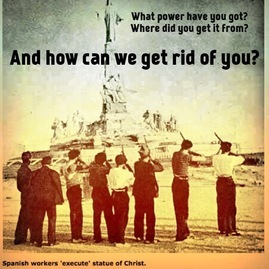 No other political or social ideology would come close to the anarchist movement of 1936 in Spain, yet by 1937 the movement had not only been dealt a death blow, but its very existence had begun to be eradicated from the minds and memory of popular history in a chilling pre-run of Orwells 1984.
No other political or social ideology would come close to the anarchist movement of 1936 in Spain, yet by 1937 the movement had not only been dealt a death blow, but its very existence had begun to be eradicated from the minds and memory of popular history in a chilling pre-run of Orwells 1984.
How could this happen? And why - 80 years later - are we seeing the shoots of the movement once more arise between the down-trodden soles of the disenchanted and unemployed in Spain? Read More here.....
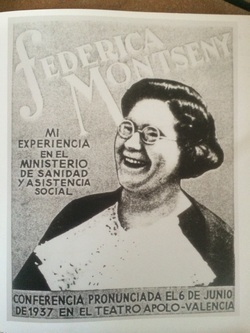 In Part 1 we saw how the anarchist groupings - particularly the CNT and the FAI helped mobilise the people of Catalunya and parts of Andalusia to take control of their own destinies. In Part 2 we saw how one man in particular, came to represent this new future: Buenaventura Durruti and how he had been persuaded to take the Durruti Column to Madrid to help defend the city from attack by Franco’s forces.
In Part 1 we saw how the anarchist groupings - particularly the CNT and the FAI helped mobilise the people of Catalunya and parts of Andalusia to take control of their own destinies. In Part 2 we saw how one man in particular, came to represent this new future: Buenaventura Durruti and how he had been persuaded to take the Durruti Column to Madrid to help defend the city from attack by Franco’s forces.
Madrid Nov. 1936
Madrid looks as though its about to fall to Franco. The Republican Government tells the Madrileños to "man the trenches" yet without telling a soul, moves itself safely to Valencia. The military committee in the capital is left to “do its best” against the professional army at its borders.
Meanwhile, the anarchists who have been hesitant about helping out a government that has done little to support their needs in Catlaunya had just invited four anarchists to become cabinet ministers - including the novelist Federica Montseny - who becomes the first woman cabinet minister in the history of Spain (In Britain it would not be until 1953 that a woman would take up a cabinet position.)
 Anarchists in government
Anarchists in government
The Anarchists in government were torn between their commitment to do away with any government and their need to help win the war. The cabinet new members persuade Durruti to come to the defense of Madrid. But the Communists are concerned that the invincible Durruti Column will prove to be the public saviour of the capital - a role they are preserving for themselves. So they persuade the Military Committee in Madrid to direct Durruti’s troops in an attack on the most vulnerable and important of fronts. They know that even this anarchist militia will have little chance of success against the well-armed and professional ranks amassed there.
When Durruti discovers this scheme, he is incensed but - as charismatic leaders tend it be - he rises to the challenge and sends his troops into the battle. But these are no ordinary disciplined ranks of soldiers - they are anarchists - and have to right to leave a battle scene if they think fit. Very quickly the anarchist troops begin to realise that they had been led into slaughter and are being used as pawns in a larger political game.
The Death of Durruti
When Durruti receives notice that his troops are deserting the battle-front - he rushes to the scene to stop them.
“Compañeros - Return” he shouts. “Cowards. In the name of FAI return and fight.”
“Why die in defence of Madrid,” they ask him. “If we are going to die it should be in defence of Catalunya. Not fed to Franco’s troops under these conditions.”
As the debate continues a shot is suddenly heard and Durruti falls to the ground. By the following morning he is dead.
Who Killed Durruti?
Durruti - the idealist - the man who had fought so hard to liberate the human spirit is no longer. Who killed the man who had charged into battle a 1000 times and never been struck by the enemy? Who was behind the shooting of Durruti? Was it an enemy sniper? Was it the communists? Or was it one of his own men that felt Durruti had finally betrayed them?
Later evidence from gunpowder samples on his clothes indicated that Durruti had been shot from a distance of just 50cm. Rumours begin to fly back and forth.
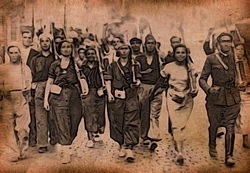 However Durruti died, the balance of power was now shifting fast. It was only the popularity and influence of Durruti that had balanced the communists increasing influence in government. Now, with Durruti out of the way, Moscow had total freedom to crush the anarchist revolution in Catalonia as they had done in Russia and in the Ukraine. Now the Communists were free to fight the war according to Stalin’s agenda.
However Durruti died, the balance of power was now shifting fast. It was only the popularity and influence of Durruti that had balanced the communists increasing influence in government. Now, with Durruti out of the way, Moscow had total freedom to crush the anarchist revolution in Catalonia as they had done in Russia and in the Ukraine. Now the Communists were free to fight the war according to Stalin’s agenda.
Many of Durruti’s column - disillusioned and in disbelief at the loss of their leader - return to Catalonia, though many stay and help fight for the defence of the city. But when 2 anarchists are found mysteriously assassinated in the streets of Madrid a few days later, they realise that they too must leave for the reprisals from Stalin's forces had begun.
The Astonishing Funeral
Durruti's body is taken back to Barcelona, where the funeral brings out the whole population of the city. 100’s of 1000’s are spilling out of every doorway, scrambling up statues to see the coffin pass by. Never before - not for royalty nor leaders of the state - had Barcelona seen this number of people come out to pay their respects. As the procession finally heads off - up goes those defiant fists once more, like a sea of resistance.
Watch the incredible footage of the Durruti Funeral Procession Up goes the procession along the Ramblas with the band playing the funeral march. Along past the USA embassy with its flag at half mast (did the Americans realise this man had robbed banks, assassinated archbishops and plotted to kill King Alfonso X III ?) It is an emotive moment for the libertarian movement and the people of Barcelona. A moment that history books may forget, but not the anarchists of Catalunya.
The Final Countdown
By May 1937, the conflict comes to a head in Barcelona as the Communists stage an assault against the CNT and the Trotskiest organisation the POUM.(Orwell’s militia group) Many are killed in the street battles, others are imprisoned or disappear and many others - like Orwell - are hounded by Soviet agents and are forced to flee undercover back to their respective countries.
The greatest social experiment the world has ever witnessed is now over. The Catalan politicians are back in government an the collectives are being dismantled, their leaders locked up or shot and the memory of the anarchist revolution is being systematically erased from history books. Even the industrial plants - modernised under the anarchist collectives - are pulled down by 1939. Even outside Spain, as Orwell discovers when trying to find a publisher for Homage to Catalunya, the world does not want to know the story of the libertarian left. The Spanish Civil War is seen as a simple struggle between democracy and fascism - a story in which the Communists came to the defence of a fledging republic and a defenceless people. History was being re-written.
Although the body of Durruti was buried at the cemetery in monjuic, it is rumoured that it was later moved. The body of Durruti, like the legacy of the anarchist movement in Spain, is hard to track down.
The legacy of the Durruti and the Anarchists
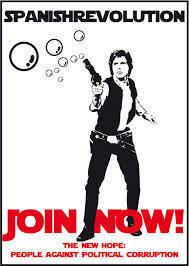 The collusion of the republican government and the pressure from the Communist Party at the end of the civil war wiped effectively wiped out the anarchist history and their revolutionary advances. Franco had little to do when he finally entered Madrid and Barcelona other clear-up what little was left of the social revolutionary movements.
The collusion of the republican government and the pressure from the Communist Party at the end of the civil war wiped effectively wiped out the anarchist history and their revolutionary advances. Franco had little to do when he finally entered Madrid and Barcelona other clear-up what little was left of the social revolutionary movements.
But he installed a regime that would create a populace fearful of such experiments again. The following generations carried in their genetic memory the consequences of such bravery and the betrayals of their ideals.
Until recently, that is.
Since 2011 things have begun to stir once more. In Spain we have seen new methods of struggle evolving - the movement in defence of the homeless (desahucios) , the intimidation of corrupt politicians (eschaches), the defence of public companies (mareas), neighbourhood voting and assemblies, the indignadas movment, occupation of public spaces, #FicticiousProtest/#GhostProtest) #spanishrevolution etc etc
History Repeats itself Collectives in Spain 1936
Collectives in Spain 1936
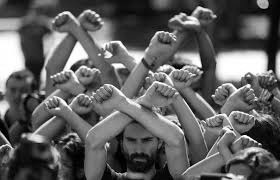 Collectives in Spain 2011 Even this week (late May 2014) we have seen EU election results with a surge of popularity for the radical left in Spain. We have seen concessions won by those organising street riots in defence of occupied housing in Barcelona, and we have seen - despite the criminalisation of such moves - the continuation of the escrache movement.
Collectives in Spain 2011 Even this week (late May 2014) we have seen EU election results with a surge of popularity for the radical left in Spain. We have seen concessions won by those organising street riots in defence of occupied housing in Barcelona, and we have seen - despite the criminalisation of such moves - the continuation of the escrache movement.
The anarchist ideals of accountability, transparency and self-government - traditionally dismissed as utopian - are not quite dead yet. As Chomsky says, whenever you have an upsurge in political activity...you will find the strands of anarchism once more on the move.
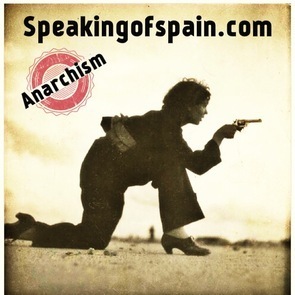 Women Anarchists Training in Barcelona *Want to know more about the history of Spain? Next mOnth a new release:
Women Anarchists Training in Barcelona *Want to know more about the history of Spain? Next mOnth a new release:
Anarchy and the Tapa: How To Kill A Social Revolution in Spain
History comes alive in this compelling story of... Anarchy in Spain The Back Hand and the Bread and Cheese Revolts The inside story of Durruti the International Activist on the run and his suspicious death. The role of George Orwell and other writers An in-depth view of the collective protest movements operating today. A new publication with classic Images, links to videos, music, speeches AND for the first few that sign up - a cut out and pin up CNT flag to unfurl on your balcony (Guaranteed 100% to unsettle your neighbours.)
Sign up below and receive the news as it happens about this and other special books.
#mc_embed_signup{background:#fff; clear:left; font:14px Helvetica,Arial,sans-serif; } /* Add your own MailChimp form style overrides in your site stylesheet or in this style block. We recommend moving this block and the preceding CSS link to the HEAD of your HTML file. */ Subscribe to the mOnks Mailing List
 No other political or social ideology would come close to the anarchist movement of 1936 in Spain, yet by 1937 the movement had not only been dealt a death blow, but its very existence had begun to be eradicated from the minds and memory of popular history in a chilling pre-run of Orwells 1984.
No other political or social ideology would come close to the anarchist movement of 1936 in Spain, yet by 1937 the movement had not only been dealt a death blow, but its very existence had begun to be eradicated from the minds and memory of popular history in a chilling pre-run of Orwells 1984.How could this happen? And why - 80 years later - are we seeing the shoots of the movement once more arise between the down-trodden soles of the disenchanted and unemployed in Spain? Read More here.....
 In Part 1 we saw how the anarchist groupings - particularly the CNT and the FAI helped mobilise the people of Catalunya and parts of Andalusia to take control of their own destinies. In Part 2 we saw how one man in particular, came to represent this new future: Buenaventura Durruti and how he had been persuaded to take the Durruti Column to Madrid to help defend the city from attack by Franco’s forces.
In Part 1 we saw how the anarchist groupings - particularly the CNT and the FAI helped mobilise the people of Catalunya and parts of Andalusia to take control of their own destinies. In Part 2 we saw how one man in particular, came to represent this new future: Buenaventura Durruti and how he had been persuaded to take the Durruti Column to Madrid to help defend the city from attack by Franco’s forces. Madrid Nov. 1936
Madrid looks as though its about to fall to Franco. The Republican Government tells the Madrileños to "man the trenches" yet without telling a soul, moves itself safely to Valencia. The military committee in the capital is left to “do its best” against the professional army at its borders.
Meanwhile, the anarchists who have been hesitant about helping out a government that has done little to support their needs in Catlaunya had just invited four anarchists to become cabinet ministers - including the novelist Federica Montseny - who becomes the first woman cabinet minister in the history of Spain (In Britain it would not be until 1953 that a woman would take up a cabinet position.)
 Anarchists in government
Anarchists in governmentThe Anarchists in government were torn between their commitment to do away with any government and their need to help win the war. The cabinet new members persuade Durruti to come to the defense of Madrid. But the Communists are concerned that the invincible Durruti Column will prove to be the public saviour of the capital - a role they are preserving for themselves. So they persuade the Military Committee in Madrid to direct Durruti’s troops in an attack on the most vulnerable and important of fronts. They know that even this anarchist militia will have little chance of success against the well-armed and professional ranks amassed there.
When Durruti discovers this scheme, he is incensed but - as charismatic leaders tend it be - he rises to the challenge and sends his troops into the battle. But these are no ordinary disciplined ranks of soldiers - they are anarchists - and have to right to leave a battle scene if they think fit. Very quickly the anarchist troops begin to realise that they had been led into slaughter and are being used as pawns in a larger political game.
The Death of Durruti
When Durruti receives notice that his troops are deserting the battle-front - he rushes to the scene to stop them.
“Compañeros - Return” he shouts. “Cowards. In the name of FAI return and fight.”
“Why die in defence of Madrid,” they ask him. “If we are going to die it should be in defence of Catalunya. Not fed to Franco’s troops under these conditions.”
As the debate continues a shot is suddenly heard and Durruti falls to the ground. By the following morning he is dead.
Who Killed Durruti?
Durruti - the idealist - the man who had fought so hard to liberate the human spirit is no longer. Who killed the man who had charged into battle a 1000 times and never been struck by the enemy? Who was behind the shooting of Durruti? Was it an enemy sniper? Was it the communists? Or was it one of his own men that felt Durruti had finally betrayed them?
Later evidence from gunpowder samples on his clothes indicated that Durruti had been shot from a distance of just 50cm. Rumours begin to fly back and forth.
 However Durruti died, the balance of power was now shifting fast. It was only the popularity and influence of Durruti that had balanced the communists increasing influence in government. Now, with Durruti out of the way, Moscow had total freedom to crush the anarchist revolution in Catalonia as they had done in Russia and in the Ukraine. Now the Communists were free to fight the war according to Stalin’s agenda.
However Durruti died, the balance of power was now shifting fast. It was only the popularity and influence of Durruti that had balanced the communists increasing influence in government. Now, with Durruti out of the way, Moscow had total freedom to crush the anarchist revolution in Catalonia as they had done in Russia and in the Ukraine. Now the Communists were free to fight the war according to Stalin’s agenda. Many of Durruti’s column - disillusioned and in disbelief at the loss of their leader - return to Catalonia, though many stay and help fight for the defence of the city. But when 2 anarchists are found mysteriously assassinated in the streets of Madrid a few days later, they realise that they too must leave for the reprisals from Stalin's forces had begun.
The Astonishing Funeral
Durruti's body is taken back to Barcelona, where the funeral brings out the whole population of the city. 100’s of 1000’s are spilling out of every doorway, scrambling up statues to see the coffin pass by. Never before - not for royalty nor leaders of the state - had Barcelona seen this number of people come out to pay their respects. As the procession finally heads off - up goes those defiant fists once more, like a sea of resistance.
Watch the incredible footage of the Durruti Funeral Procession Up goes the procession along the Ramblas with the band playing the funeral march. Along past the USA embassy with its flag at half mast (did the Americans realise this man had robbed banks, assassinated archbishops and plotted to kill King Alfonso X III ?) It is an emotive moment for the libertarian movement and the people of Barcelona. A moment that history books may forget, but not the anarchists of Catalunya.
The Final Countdown
By May 1937, the conflict comes to a head in Barcelona as the Communists stage an assault against the CNT and the Trotskiest organisation the POUM.(Orwell’s militia group) Many are killed in the street battles, others are imprisoned or disappear and many others - like Orwell - are hounded by Soviet agents and are forced to flee undercover back to their respective countries.
The greatest social experiment the world has ever witnessed is now over. The Catalan politicians are back in government an the collectives are being dismantled, their leaders locked up or shot and the memory of the anarchist revolution is being systematically erased from history books. Even the industrial plants - modernised under the anarchist collectives - are pulled down by 1939. Even outside Spain, as Orwell discovers when trying to find a publisher for Homage to Catalunya, the world does not want to know the story of the libertarian left. The Spanish Civil War is seen as a simple struggle between democracy and fascism - a story in which the Communists came to the defence of a fledging republic and a defenceless people. History was being re-written.
Although the body of Durruti was buried at the cemetery in monjuic, it is rumoured that it was later moved. The body of Durruti, like the legacy of the anarchist movement in Spain, is hard to track down.
The legacy of the Durruti and the Anarchists
 The collusion of the republican government and the pressure from the Communist Party at the end of the civil war wiped effectively wiped out the anarchist history and their revolutionary advances. Franco had little to do when he finally entered Madrid and Barcelona other clear-up what little was left of the social revolutionary movements.
The collusion of the republican government and the pressure from the Communist Party at the end of the civil war wiped effectively wiped out the anarchist history and their revolutionary advances. Franco had little to do when he finally entered Madrid and Barcelona other clear-up what little was left of the social revolutionary movements.But he installed a regime that would create a populace fearful of such experiments again. The following generations carried in their genetic memory the consequences of such bravery and the betrayals of their ideals.
Until recently, that is.
Since 2011 things have begun to stir once more. In Spain we have seen new methods of struggle evolving - the movement in defence of the homeless (desahucios) , the intimidation of corrupt politicians (eschaches), the defence of public companies (mareas), neighbourhood voting and assemblies, the indignadas movment, occupation of public spaces, #FicticiousProtest/#GhostProtest) #spanishrevolution etc etc
History Repeats itself
 Collectives in Spain 1936
Collectives in Spain 1936
 Collectives in Spain 2011 Even this week (late May 2014) we have seen EU election results with a surge of popularity for the radical left in Spain. We have seen concessions won by those organising street riots in defence of occupied housing in Barcelona, and we have seen - despite the criminalisation of such moves - the continuation of the escrache movement.
Collectives in Spain 2011 Even this week (late May 2014) we have seen EU election results with a surge of popularity for the radical left in Spain. We have seen concessions won by those organising street riots in defence of occupied housing in Barcelona, and we have seen - despite the criminalisation of such moves - the continuation of the escrache movement.The anarchist ideals of accountability, transparency and self-government - traditionally dismissed as utopian - are not quite dead yet. As Chomsky says, whenever you have an upsurge in political activity...you will find the strands of anarchism once more on the move.
 Women Anarchists Training in Barcelona *Want to know more about the history of Spain? Next mOnth a new release:
Women Anarchists Training in Barcelona *Want to know more about the history of Spain? Next mOnth a new release: Anarchy and the Tapa: How To Kill A Social Revolution in Spain
History comes alive in this compelling story of... Anarchy in Spain The Back Hand and the Bread and Cheese Revolts The inside story of Durruti the International Activist on the run and his suspicious death. The role of George Orwell and other writers An in-depth view of the collective protest movements operating today. A new publication with classic Images, links to videos, music, speeches AND for the first few that sign up - a cut out and pin up CNT flag to unfurl on your balcony (Guaranteed 100% to unsettle your neighbours.)
Sign up below and receive the news as it happens about this and other special books.
#mc_embed_signup{background:#fff; clear:left; font:14px Helvetica,Arial,sans-serif; } /* Add your own MailChimp form style overrides in your site stylesheet or in this style block. We recommend moving this block and the preceding CSS link to the HEAD of your HTML file. */ Subscribe to the mOnks Mailing List
Published on June 01, 2014 08:05
No comments have been added yet.
Speaking Of Spain
History, revolution, music, videos and articles on another view of life in Spain by the Gazpachomonk
- Paul Read's profile
- 25 followers



